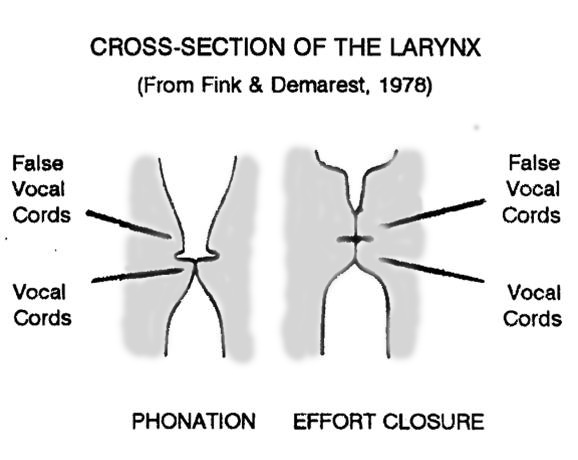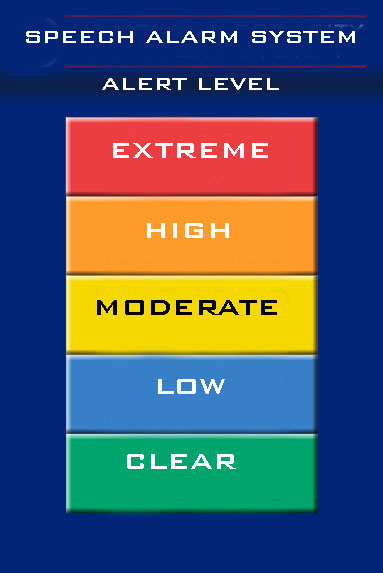Valsalva-Stuttering Blocks Revisited
In persistent developmental
stuttering (the most common form of stuttering in adults and teenagers),
the actual �block?occurs in the brain before the person who stutters even
tries to say the word. The block is an error in the neurological
motor programming of the larynx to phonate the vowel sound of a
specific word or syllable.
 Before
any bodily movement can occur, the brain must first create a motor
program to determine when and how muscles are to be activated. The
same is true for speech. A neurological process called prephonatory
tuning must prepare the appropriate muscles in the larynx to bring the
vocal folds together at the proper time to vibrate as airflow passes
between them. The vibrating vocal folds create a buzzing noise. The buzz
is turned into specific vowel sounds by the shape of the oral cavity, as
determined by the position of the lips and tongue.
Before
any bodily movement can occur, the brain must first create a motor
program to determine when and how muscles are to be activated. The
same is true for speech. A neurological process called prephonatory
tuning must prepare the appropriate muscles in the larynx to bring the
vocal folds together at the proper time to vibrate as airflow passes
between them. The vibrating vocal folds create a buzzing noise. The buzz
is turned into specific vowel sounds by the shape of the oral cavity, as
determined by the position of the lips and tongue.
When the person who stutters
comes to the word or syllable in question, the brain does not program the
larynx to phonate the vowel sound. Instead, the larynx is programmed for
effort closure ?the function that it performs during a Valsalva
maneuver. For that reason, we will call these blocks
�Valsalva-stuttering blocks.?nbsp; The vowel sound is the natural place
for motor programming for effort to occur, because it is the part of the
syllable that is loudest and therefore has the most energy.
In effort closure, the
entire larynx closes tightly ?including both the vocal folds and the
false vocal folds above them ?to keep air from escaping. The purpose is
to build up air pressure in the lungs to stiffen the trunk of the body, so
that physical effort can be exerted more efficiently. Often the person
who stutters will feel tightness in the throat as well as the abdominal
muscles. Even if the larynx does not actually close, it still is not
ready to play its part in saying the vowel.
The rest of the speech
mechanism ?the lips and tongue ?must now wait until the larynx is ready
to phonate the vowel sound. The person�s speech gets stuck on the
consonant or glottal stop that precedes the vowel, resulting in
repetitions, prolongations, hesitations, and/or forceful closures of the
mouth or larynx. This creates a false impression that the initial sound
is causing the problem.
It should be noted that a
stutterer�s lips and tongue usually have no trouble articulating words on
their own, when they don�t have to wait for the larynx to phonate. For
example, a person who stutters is almost always fluent when there is no
phonation, as in whispering, or when phonation is continuous, as in
the �Humdronian Speech Exercise?or singing.
The person who stutters may
feel as if the feared word contains an insurmountable obstacle ?often
described as a �brick wall??that requires force to overcome. The PWS
may be overwhelmed by a seemingly uncontrollable urge to use physical
effort to force the word out ?as in a Valsalva maneuver. This may
instinctively feel like the right thing ?the only thing ?
to do. But the more the speaker builds up air pressure to break through
the perceived block, the stronger the block becomes.
The
Block Is an Illusion
In reality, there is no
obstacle or �brick wall.? It is an illusion, with no substance or power
of its own. Its only power comes from you.
You yourself create the
obstacle by exerting effort in trying to force through it. That is the
essence of a Valsalva maneuver. The blockage of the upper airway
automatically becomes stronger to resist the air pressure that you build
up in your lungs. The purpose is to stiffen the trunk of the body to help
you exert physical effort more efficiently. This maneuver is totally
inappropriate for speech. You may feel as if you are b eing
conscientious by �trying hard,?but you are creating the very obstacle
that you are struggling against.
eing
conscientious by �trying hard,?but you are creating the very obstacle
that you are struggling against.
A well-known example of this
principle is the Chinese finger trap. A person inserts an index
finger into each end of a woven bamboo tube and then tries to free them.
The instinctive reaction is to pull the fingers outward, but the harder
the person pulls, the tighter the tube becomes. The victim ends up
trapping himself by his own effort in trying to escape.
Stuttering Blocks and Anxiety
Valsalva-stuttering blocks
are associated with varying degrees of anxiety, as illustrated in the
following diagram. The degree of anxiety may affect a block�s resistance
to therapy.
Low-Anxiety
Blocks
High-Anxiety Blocks

 The �Speech
Alarm System?/span>
The �Speech
Alarm System?/span>
As discussed in
The Neurological Triggering
of Stuttering Blocks, the triggering of stuttering blocks is similar
to the sympathetic nervous system�s �fight-flight-freeze?response to
fearful stimuli. The purpose of this response is to keep us safe by
causing our bodies to react instantly and automatically to potential
danger. This reaction is initiated by the almond-shaped amygdalae
?the parts of the brain in which fearful memories are stored. (There
is one amygdala in each hemisphere.)
The amygdalae�s sensitivity
to stimuli may vary, depending on the situation. For example, if you were
strolling through a safe, quiet neighborhood during the day, your
amygdalae would probably be on a low alert level, allowing you to think
pleasant thoughts and enjoy yourself. In contrast, if you had to walk
through a crime-infested neighborhood at night, your amygdalae would
probably be on high alert for muggers. Any movement in the shadows might
cause them to send an alarm ?triggering the release of stress hormones
through your brain and body.
 Likewise,
the triggering of stuttering blocks may vary greatly, depending on the
speaking situation. We might better understand this variance if we view
it in terms of a ?b>Speech Alarm System.?/span>
Likewise,
the triggering of stuttering blocks may vary greatly, depending on the
speaking situation. We might better understand this variance if we view
it in terms of a ?b>Speech Alarm System.?/span>
We will visualize the Speech
Alarm System as having the following color-coded �Alert Levels?
As you enter speaking
situations, you may habitually set the sensitivity of your �Speech Alarm
System?based on your memories, thoughts, expectations, attitudes, and
beliefs about the difficulty or danger of the speaking situation and/or
the words you anticipate saying.
The following is a
hypothetical example of how the Speech Alarm System might work. This
process may be conscious, unconscious, or semi-conscious. It may seem to
you as being so necessary, automatic, and inevitable that you feel you
have no choice in the matter.
Your amygdalae are now on
Extreme Alert for the dreaded �p-words?(or whatever other type of word
you might fear). As you come to a �p-word,?your amygdalae send out an
alarm: �Danger! Danger!?nbsp; This triggers your sympathetic nervous
system to initiate the fight-flight-freeze response, which floods your
brain and body with stress hormones.
These hormones cause your
larynx to be neurologically programmed to do effort closure instead
of phonating the vowel sound of the specific word or syllable. (Doing
effort closure as part of a Valsalva maneuver is an instinctive way to
prepare your body for physical action.) The stress hormones also shut
down the thinking part of your brain, causing you to forget everything you
may have learned in speech therapy. You instinctively revert back to your
old, established struggle or avoidance behaviors ?as if no other choices
are possible. All the while, the stress hormones are urging you to
�Force! Force!??as if you were in real danger and needed to fight off a
mugger.
But there is no mugger. It
is only a word. You are safe. Your Speech Alarm System has given you a
false alarm. Because speaking situations present no real dangers,
all of its alarms are false alarms.
The Speech Alarm System is
actually unnecessary and counter-productive. Nevertheless, you keep using
it because, on some psychological level, it helps you feel safe.
You might feel naked and exposed ?and perhaps even terrified ?without
it. Exerting effort in response to the alarms set off by your amygdalae
has the immediate short-term effect of reducing your anxiety. Over the
long term, however, responding to these false alarms perpetuates your
fears and stuttering behaviors.
Back to top.
Copyright ?2012 by William D. Parry
![]()